Ethical Decision Making: Analyzing Rules and Business Case Studies
VerifiedAdded on 2022/09/21
|9
|2364
|36
Essay
AI Summary
This essay delves into the critical realm of ethical decision-making within a business context, providing a comprehensive exploration of four fundamental ethical rules: utilitarianism, moral rights, justice, and practical ethics. The essay begins by establishing a foundational understanding of ethics and its significance in guiding business conduct, emphasizing the importance of making choices that uphold ethical codes and foster trust. It then proceeds to dissect each ethical rule, offering detailed explanations of their principles and practical applications. For utilitarianism, the essay highlights its focus on maximizing overall happiness and its relevance in assessing the impact of decisions on stakeholders. The discussion of moral rights emphasizes the protection of fundamental human rights and liberties, while justice is presented as a framework for ensuring fairness and impartiality in the distribution of benefits. Finally, practical ethics is examined as a rule that emphasizes the importance of open communication and considering the real-world implications of decisions. The essay concludes by underscoring the interconnectedness of these ethical rules, suggesting that managers must consider all aspects when faced with ethical dilemmas. The essay uses a case study about an aerospace manufacturer to demonstrate the practical application of these ethical rules. This essay provides a valuable resource for students and professionals seeking to enhance their understanding of ethical decision-making in the business world.
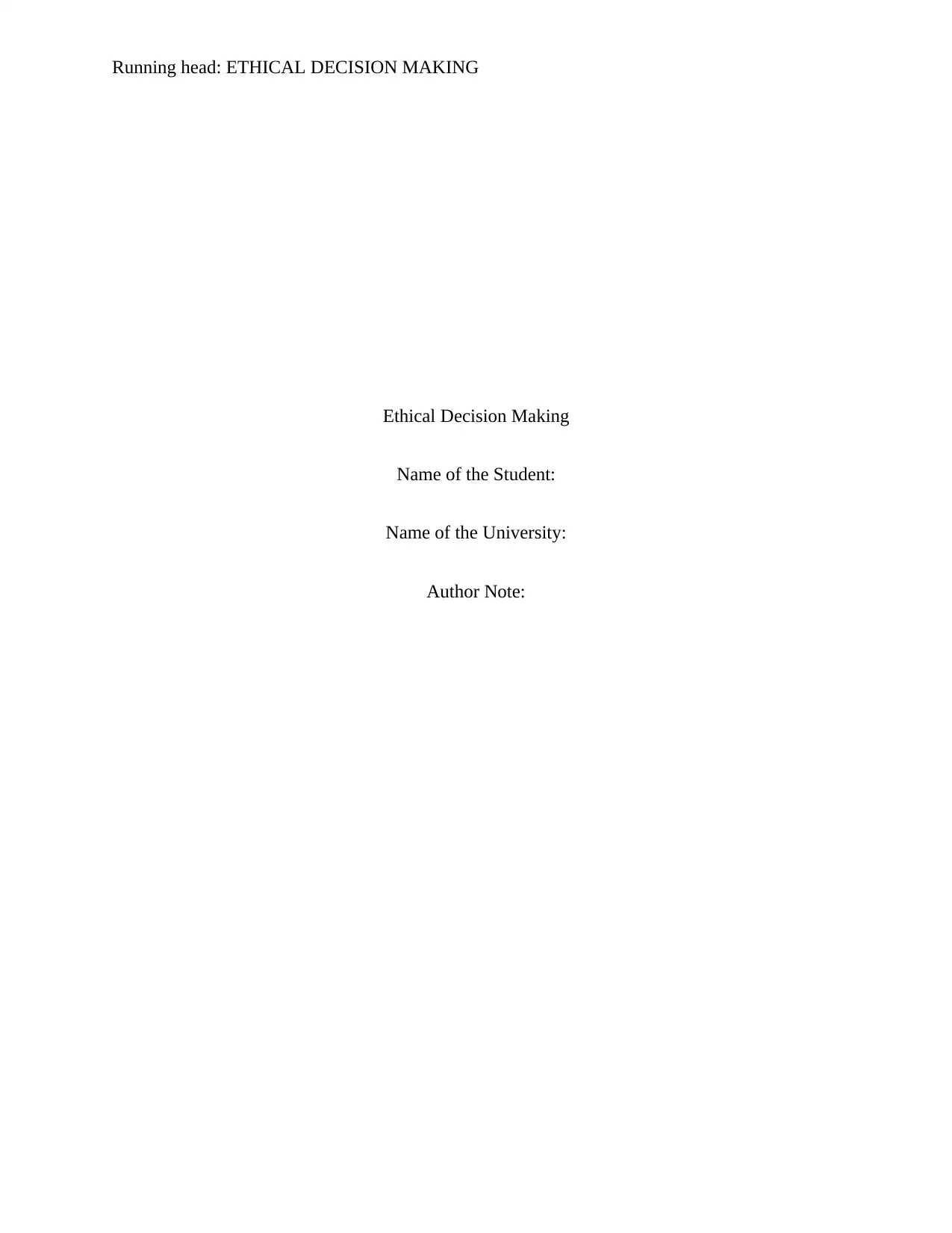
Running head: ETHICAL DECISION MAKING
Ethical Decision Making
Name of the Student:
Name of the University:
Author Note:
Ethical Decision Making
Name of the Student:
Name of the University:
Author Note:
Paraphrase This Document
Need a fresh take? Get an instant paraphrase of this document with our AI Paraphraser
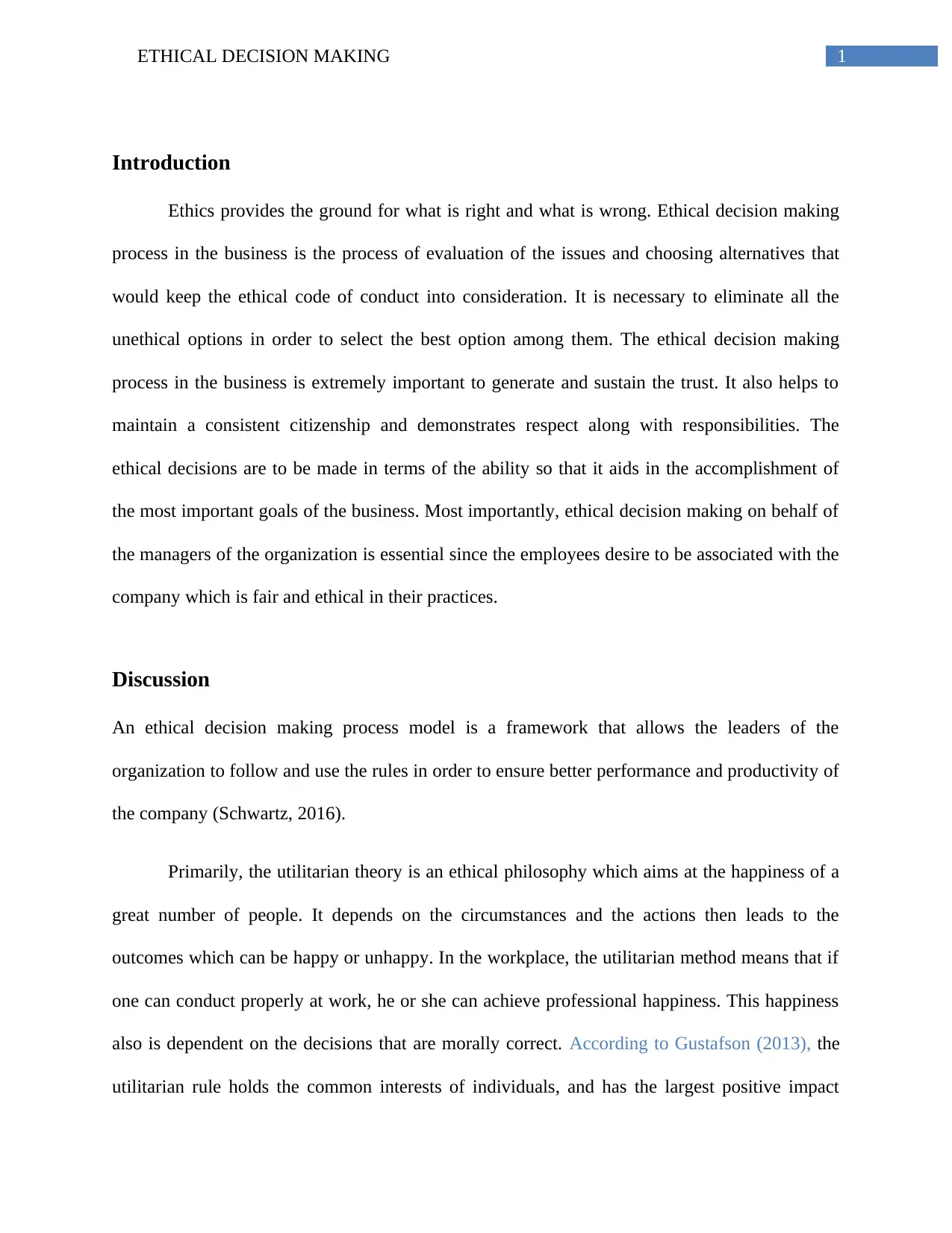
1ETHICAL DECISION MAKING
Introduction
Ethics provides the ground for what is right and what is wrong. Ethical decision making
process in the business is the process of evaluation of the issues and choosing alternatives that
would keep the ethical code of conduct into consideration. It is necessary to eliminate all the
unethical options in order to select the best option among them. The ethical decision making
process in the business is extremely important to generate and sustain the trust. It also helps to
maintain a consistent citizenship and demonstrates respect along with responsibilities. The
ethical decisions are to be made in terms of the ability so that it aids in the accomplishment of
the most important goals of the business. Most importantly, ethical decision making on behalf of
the managers of the organization is essential since the employees desire to be associated with the
company which is fair and ethical in their practices.
Discussion
An ethical decision making process model is a framework that allows the leaders of the
organization to follow and use the rules in order to ensure better performance and productivity of
the company (Schwartz, 2016).
Primarily, the utilitarian theory is an ethical philosophy which aims at the happiness of a
great number of people. It depends on the circumstances and the actions then leads to the
outcomes which can be happy or unhappy. In the workplace, the utilitarian method means that if
one can conduct properly at work, he or she can achieve professional happiness. This happiness
also is dependent on the decisions that are morally correct. According to Gustafson (2013), the
utilitarian rule holds the common interests of individuals, and has the largest positive impact
Introduction
Ethics provides the ground for what is right and what is wrong. Ethical decision making
process in the business is the process of evaluation of the issues and choosing alternatives that
would keep the ethical code of conduct into consideration. It is necessary to eliminate all the
unethical options in order to select the best option among them. The ethical decision making
process in the business is extremely important to generate and sustain the trust. It also helps to
maintain a consistent citizenship and demonstrates respect along with responsibilities. The
ethical decisions are to be made in terms of the ability so that it aids in the accomplishment of
the most important goals of the business. Most importantly, ethical decision making on behalf of
the managers of the organization is essential since the employees desire to be associated with the
company which is fair and ethical in their practices.
Discussion
An ethical decision making process model is a framework that allows the leaders of the
organization to follow and use the rules in order to ensure better performance and productivity of
the company (Schwartz, 2016).
Primarily, the utilitarian theory is an ethical philosophy which aims at the happiness of a
great number of people. It depends on the circumstances and the actions then leads to the
outcomes which can be happy or unhappy. In the workplace, the utilitarian method means that if
one can conduct properly at work, he or she can achieve professional happiness. This happiness
also is dependent on the decisions that are morally correct. According to Gustafson (2013), the
utilitarian rule holds the common interests of individuals, and has the largest positive impact
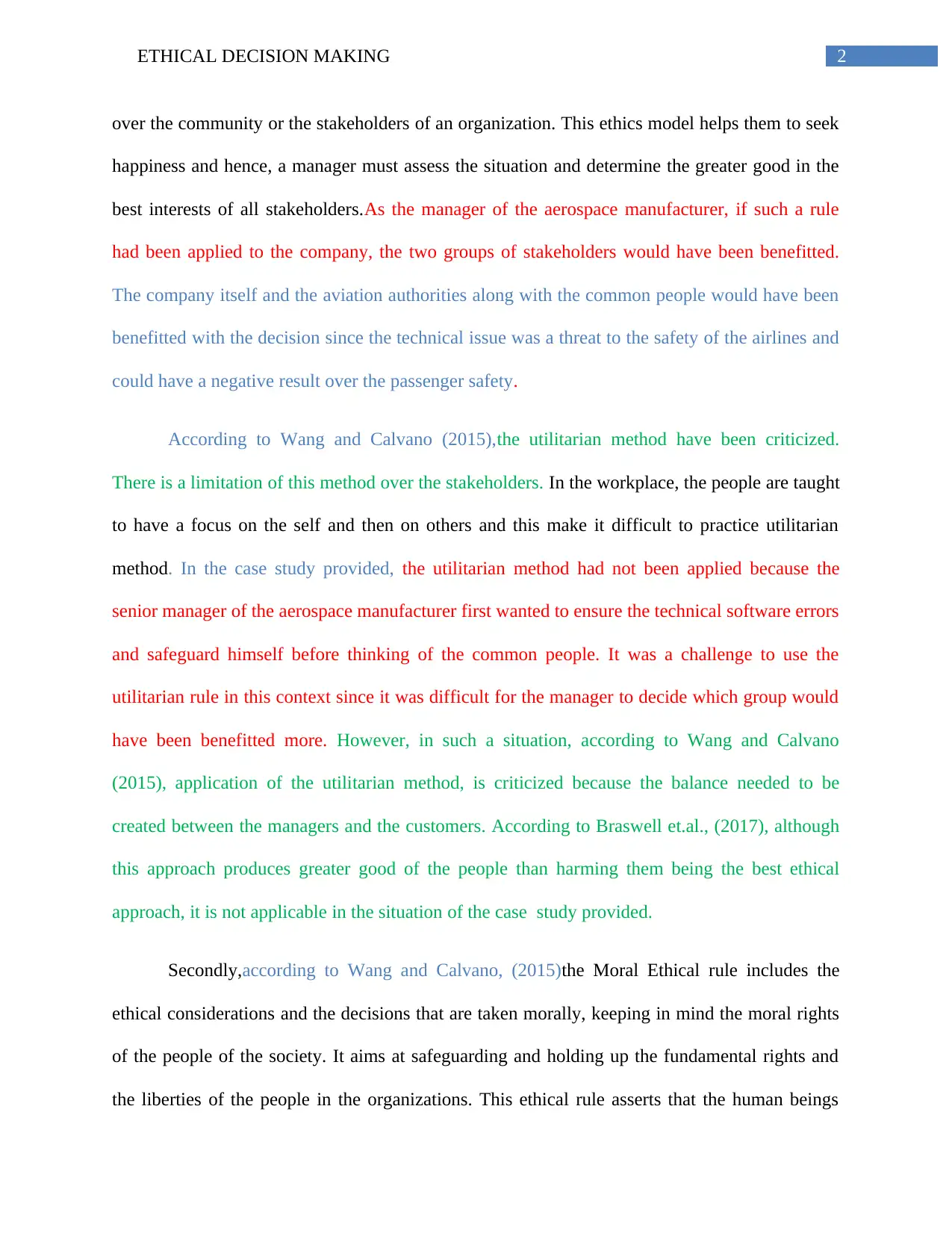
2ETHICAL DECISION MAKING
over the community or the stakeholders of an organization. This ethics model helps them to seek
happiness and hence, a manager must assess the situation and determine the greater good in the
best interests of all stakeholders.As the manager of the aerospace manufacturer, if such a rule
had been applied to the company, the two groups of stakeholders would have been benefitted.
The company itself and the aviation authorities along with the common people would have been
benefitted with the decision since the technical issue was a threat to the safety of the airlines and
could have a negative result over the passenger safety.
According to Wang and Calvano (2015),the utilitarian method have been criticized.
There is a limitation of this method over the stakeholders. In the workplace, the people are taught
to have a focus on the self and then on others and this make it difficult to practice utilitarian
method. In the case study provided, the utilitarian method had not been applied because the
senior manager of the aerospace manufacturer first wanted to ensure the technical software errors
and safeguard himself before thinking of the common people. It was a challenge to use the
utilitarian rule in this context since it was difficult for the manager to decide which group would
have been benefitted more. However, in such a situation, according to Wang and Calvano
(2015), application of the utilitarian method, is criticized because the balance needed to be
created between the managers and the customers. According to Braswell et.al., (2017), although
this approach produces greater good of the people than harming them being the best ethical
approach, it is not applicable in the situation of the case study provided.
Secondly,according to Wang and Calvano, (2015)the Moral Ethical rule includes the
ethical considerations and the decisions that are taken morally, keeping in mind the moral rights
of the people of the society. It aims at safeguarding and holding up the fundamental rights and
the liberties of the people in the organizations. This ethical rule asserts that the human beings
over the community or the stakeholders of an organization. This ethics model helps them to seek
happiness and hence, a manager must assess the situation and determine the greater good in the
best interests of all stakeholders.As the manager of the aerospace manufacturer, if such a rule
had been applied to the company, the two groups of stakeholders would have been benefitted.
The company itself and the aviation authorities along with the common people would have been
benefitted with the decision since the technical issue was a threat to the safety of the airlines and
could have a negative result over the passenger safety.
According to Wang and Calvano (2015),the utilitarian method have been criticized.
There is a limitation of this method over the stakeholders. In the workplace, the people are taught
to have a focus on the self and then on others and this make it difficult to practice utilitarian
method. In the case study provided, the utilitarian method had not been applied because the
senior manager of the aerospace manufacturer first wanted to ensure the technical software errors
and safeguard himself before thinking of the common people. It was a challenge to use the
utilitarian rule in this context since it was difficult for the manager to decide which group would
have been benefitted more. However, in such a situation, according to Wang and Calvano
(2015), application of the utilitarian method, is criticized because the balance needed to be
created between the managers and the customers. According to Braswell et.al., (2017), although
this approach produces greater good of the people than harming them being the best ethical
approach, it is not applicable in the situation of the case study provided.
Secondly,according to Wang and Calvano, (2015)the Moral Ethical rule includes the
ethical considerations and the decisions that are taken morally, keeping in mind the moral rights
of the people of the society. It aims at safeguarding and holding up the fundamental rights and
the liberties of the people in the organizations. This ethical rule asserts that the human beings
⊘ This is a preview!⊘
Do you want full access?
Subscribe today to unlock all pages.

Trusted by 1+ million students worldwide
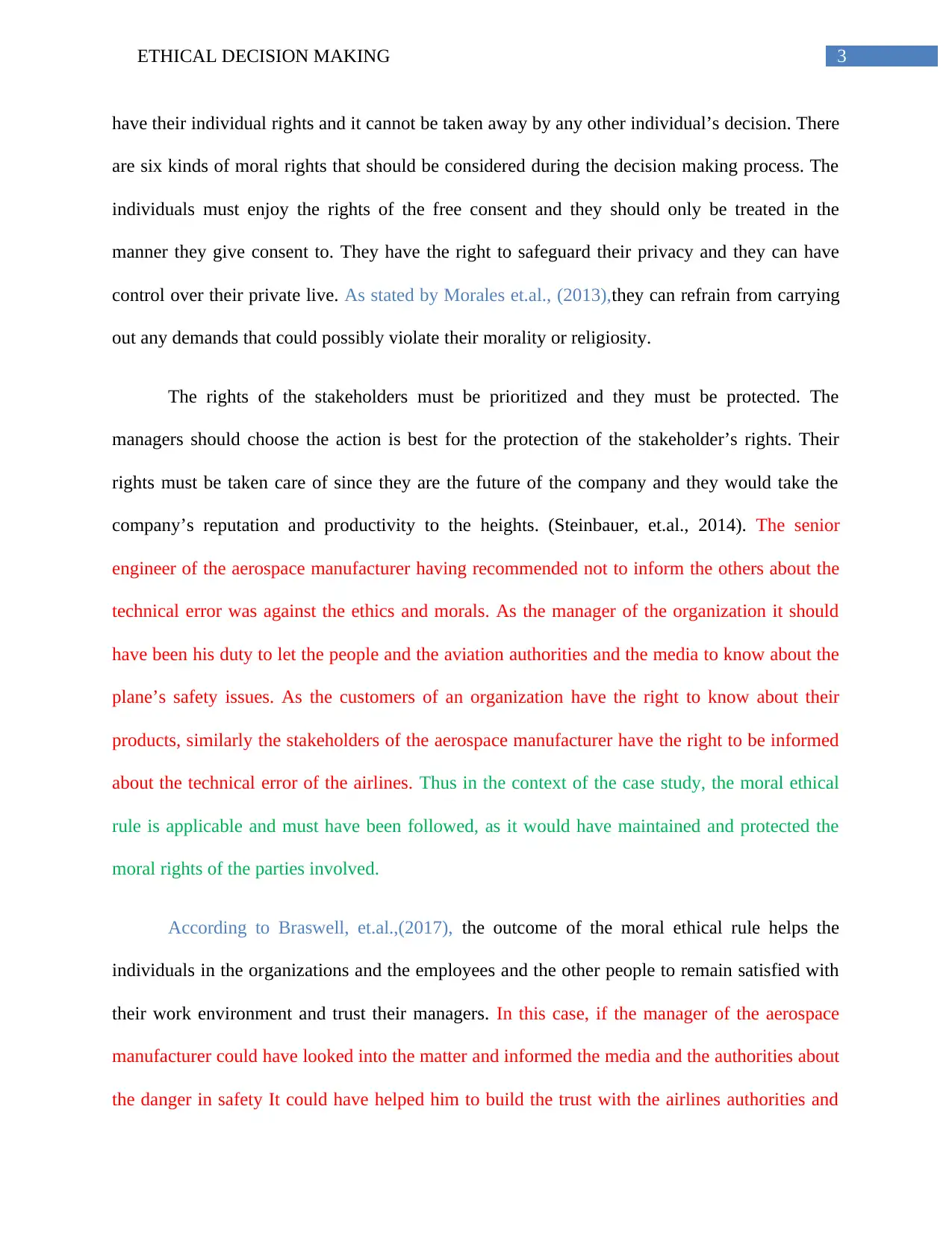
3ETHICAL DECISION MAKING
have their individual rights and it cannot be taken away by any other individual’s decision. There
are six kinds of moral rights that should be considered during the decision making process. The
individuals must enjoy the rights of the free consent and they should only be treated in the
manner they give consent to. They have the right to safeguard their privacy and they can have
control over their private live. As stated by Morales et.al., (2013),they can refrain from carrying
out any demands that could possibly violate their morality or religiosity.
The rights of the stakeholders must be prioritized and they must be protected. The
managers should choose the action is best for the protection of the stakeholder’s rights. Their
rights must be taken care of since they are the future of the company and they would take the
company’s reputation and productivity to the heights. (Steinbauer, et.al., 2014). The senior
engineer of the aerospace manufacturer having recommended not to inform the others about the
technical error was against the ethics and morals. As the manager of the organization it should
have been his duty to let the people and the aviation authorities and the media to know about the
plane’s safety issues. As the customers of an organization have the right to know about their
products, similarly the stakeholders of the aerospace manufacturer have the right to be informed
about the technical error of the airlines. Thus in the context of the case study, the moral ethical
rule is applicable and must have been followed, as it would have maintained and protected the
moral rights of the parties involved.
According to Braswell, et.al.,(2017), the outcome of the moral ethical rule helps the
individuals in the organizations and the employees and the other people to remain satisfied with
their work environment and trust their managers. In this case, if the manager of the aerospace
manufacturer could have looked into the matter and informed the media and the authorities about
the danger in safety It could have helped him to build the trust with the airlines authorities and
have their individual rights and it cannot be taken away by any other individual’s decision. There
are six kinds of moral rights that should be considered during the decision making process. The
individuals must enjoy the rights of the free consent and they should only be treated in the
manner they give consent to. They have the right to safeguard their privacy and they can have
control over their private live. As stated by Morales et.al., (2013),they can refrain from carrying
out any demands that could possibly violate their morality or religiosity.
The rights of the stakeholders must be prioritized and they must be protected. The
managers should choose the action is best for the protection of the stakeholder’s rights. Their
rights must be taken care of since they are the future of the company and they would take the
company’s reputation and productivity to the heights. (Steinbauer, et.al., 2014). The senior
engineer of the aerospace manufacturer having recommended not to inform the others about the
technical error was against the ethics and morals. As the manager of the organization it should
have been his duty to let the people and the aviation authorities and the media to know about the
plane’s safety issues. As the customers of an organization have the right to know about their
products, similarly the stakeholders of the aerospace manufacturer have the right to be informed
about the technical error of the airlines. Thus in the context of the case study, the moral ethical
rule is applicable and must have been followed, as it would have maintained and protected the
moral rights of the parties involved.
According to Braswell, et.al.,(2017), the outcome of the moral ethical rule helps the
individuals in the organizations and the employees and the other people to remain satisfied with
their work environment and trust their managers. In this case, if the manager of the aerospace
manufacturer could have looked into the matter and informed the media and the authorities about
the danger in safety It could have helped him to build the trust with the airlines authorities and
Paraphrase This Document
Need a fresh take? Get an instant paraphrase of this document with our AI Paraphraser
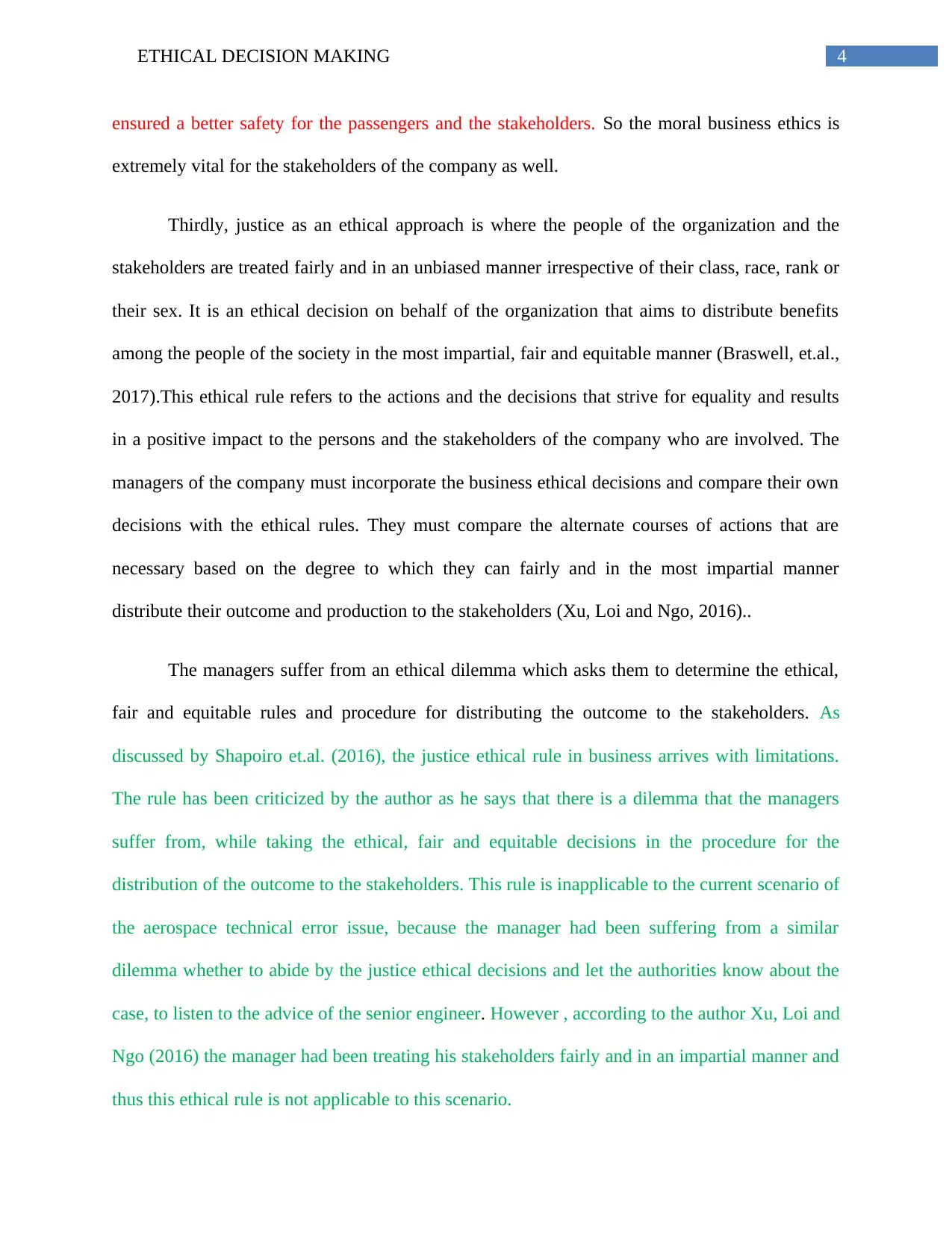
4ETHICAL DECISION MAKING
ensured a better safety for the passengers and the stakeholders. So the moral business ethics is
extremely vital for the stakeholders of the company as well.
Thirdly, justice as an ethical approach is where the people of the organization and the
stakeholders are treated fairly and in an unbiased manner irrespective of their class, race, rank or
their sex. It is an ethical decision on behalf of the organization that aims to distribute benefits
among the people of the society in the most impartial, fair and equitable manner (Braswell, et.al.,
2017).This ethical rule refers to the actions and the decisions that strive for equality and results
in a positive impact to the persons and the stakeholders of the company who are involved. The
managers of the company must incorporate the business ethical decisions and compare their own
decisions with the ethical rules. They must compare the alternate courses of actions that are
necessary based on the degree to which they can fairly and in the most impartial manner
distribute their outcome and production to the stakeholders (Xu, Loi and Ngo, 2016)..
The managers suffer from an ethical dilemma which asks them to determine the ethical,
fair and equitable rules and procedure for distributing the outcome to the stakeholders. As
discussed by Shapoiro et.al. (2016), the justice ethical rule in business arrives with limitations.
The rule has been criticized by the author as he says that there is a dilemma that the managers
suffer from, while taking the ethical, fair and equitable decisions in the procedure for the
distribution of the outcome to the stakeholders. This rule is inapplicable to the current scenario of
the aerospace technical error issue, because the manager had been suffering from a similar
dilemma whether to abide by the justice ethical decisions and let the authorities know about the
case, to listen to the advice of the senior engineer. However , according to the author Xu, Loi and
Ngo (2016) the manager had been treating his stakeholders fairly and in an impartial manner and
thus this ethical rule is not applicable to this scenario.
ensured a better safety for the passengers and the stakeholders. So the moral business ethics is
extremely vital for the stakeholders of the company as well.
Thirdly, justice as an ethical approach is where the people of the organization and the
stakeholders are treated fairly and in an unbiased manner irrespective of their class, race, rank or
their sex. It is an ethical decision on behalf of the organization that aims to distribute benefits
among the people of the society in the most impartial, fair and equitable manner (Braswell, et.al.,
2017).This ethical rule refers to the actions and the decisions that strive for equality and results
in a positive impact to the persons and the stakeholders of the company who are involved. The
managers of the company must incorporate the business ethical decisions and compare their own
decisions with the ethical rules. They must compare the alternate courses of actions that are
necessary based on the degree to which they can fairly and in the most impartial manner
distribute their outcome and production to the stakeholders (Xu, Loi and Ngo, 2016)..
The managers suffer from an ethical dilemma which asks them to determine the ethical,
fair and equitable rules and procedure for distributing the outcome to the stakeholders. As
discussed by Shapoiro et.al. (2016), the justice ethical rule in business arrives with limitations.
The rule has been criticized by the author as he says that there is a dilemma that the managers
suffer from, while taking the ethical, fair and equitable decisions in the procedure for the
distribution of the outcome to the stakeholders. This rule is inapplicable to the current scenario of
the aerospace technical error issue, because the manager had been suffering from a similar
dilemma whether to abide by the justice ethical decisions and let the authorities know about the
case, to listen to the advice of the senior engineer. However , according to the author Xu, Loi and
Ngo (2016) the manager had been treating his stakeholders fairly and in an impartial manner and
thus this ethical rule is not applicable to this scenario.
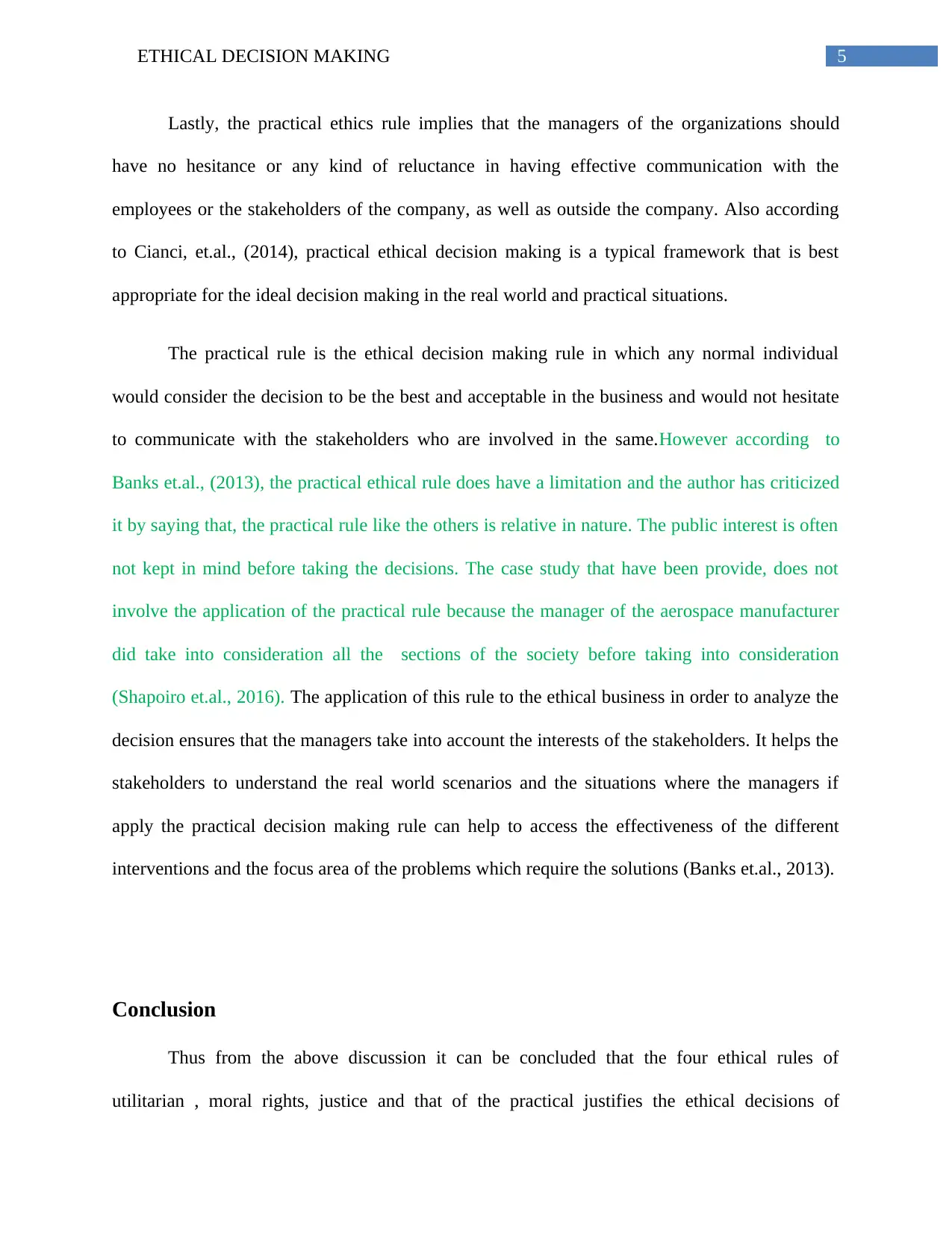
5ETHICAL DECISION MAKING
Lastly, the practical ethics rule implies that the managers of the organizations should
have no hesitance or any kind of reluctance in having effective communication with the
employees or the stakeholders of the company, as well as outside the company. Also according
to Cianci, et.al., (2014), practical ethical decision making is a typical framework that is best
appropriate for the ideal decision making in the real world and practical situations.
The practical rule is the ethical decision making rule in which any normal individual
would consider the decision to be the best and acceptable in the business and would not hesitate
to communicate with the stakeholders who are involved in the same.However according to
Banks et.al., (2013), the practical ethical rule does have a limitation and the author has criticized
it by saying that, the practical rule like the others is relative in nature. The public interest is often
not kept in mind before taking the decisions. The case study that have been provide, does not
involve the application of the practical rule because the manager of the aerospace manufacturer
did take into consideration all the sections of the society before taking into consideration
(Shapoiro et.al., 2016). The application of this rule to the ethical business in order to analyze the
decision ensures that the managers take into account the interests of the stakeholders. It helps the
stakeholders to understand the real world scenarios and the situations where the managers if
apply the practical decision making rule can help to access the effectiveness of the different
interventions and the focus area of the problems which require the solutions (Banks et.al., 2013).
Conclusion
Thus from the above discussion it can be concluded that the four ethical rules of
utilitarian , moral rights, justice and that of the practical justifies the ethical decisions of
Lastly, the practical ethics rule implies that the managers of the organizations should
have no hesitance or any kind of reluctance in having effective communication with the
employees or the stakeholders of the company, as well as outside the company. Also according
to Cianci, et.al., (2014), practical ethical decision making is a typical framework that is best
appropriate for the ideal decision making in the real world and practical situations.
The practical rule is the ethical decision making rule in which any normal individual
would consider the decision to be the best and acceptable in the business and would not hesitate
to communicate with the stakeholders who are involved in the same.However according to
Banks et.al., (2013), the practical ethical rule does have a limitation and the author has criticized
it by saying that, the practical rule like the others is relative in nature. The public interest is often
not kept in mind before taking the decisions. The case study that have been provide, does not
involve the application of the practical rule because the manager of the aerospace manufacturer
did take into consideration all the sections of the society before taking into consideration
(Shapoiro et.al., 2016). The application of this rule to the ethical business in order to analyze the
decision ensures that the managers take into account the interests of the stakeholders. It helps the
stakeholders to understand the real world scenarios and the situations where the managers if
apply the practical decision making rule can help to access the effectiveness of the different
interventions and the focus area of the problems which require the solutions (Banks et.al., 2013).
Conclusion
Thus from the above discussion it can be concluded that the four ethical rules of
utilitarian , moral rights, justice and that of the practical justifies the ethical decisions of
⊘ This is a preview!⊘
Do you want full access?
Subscribe today to unlock all pages.

Trusted by 1+ million students worldwide
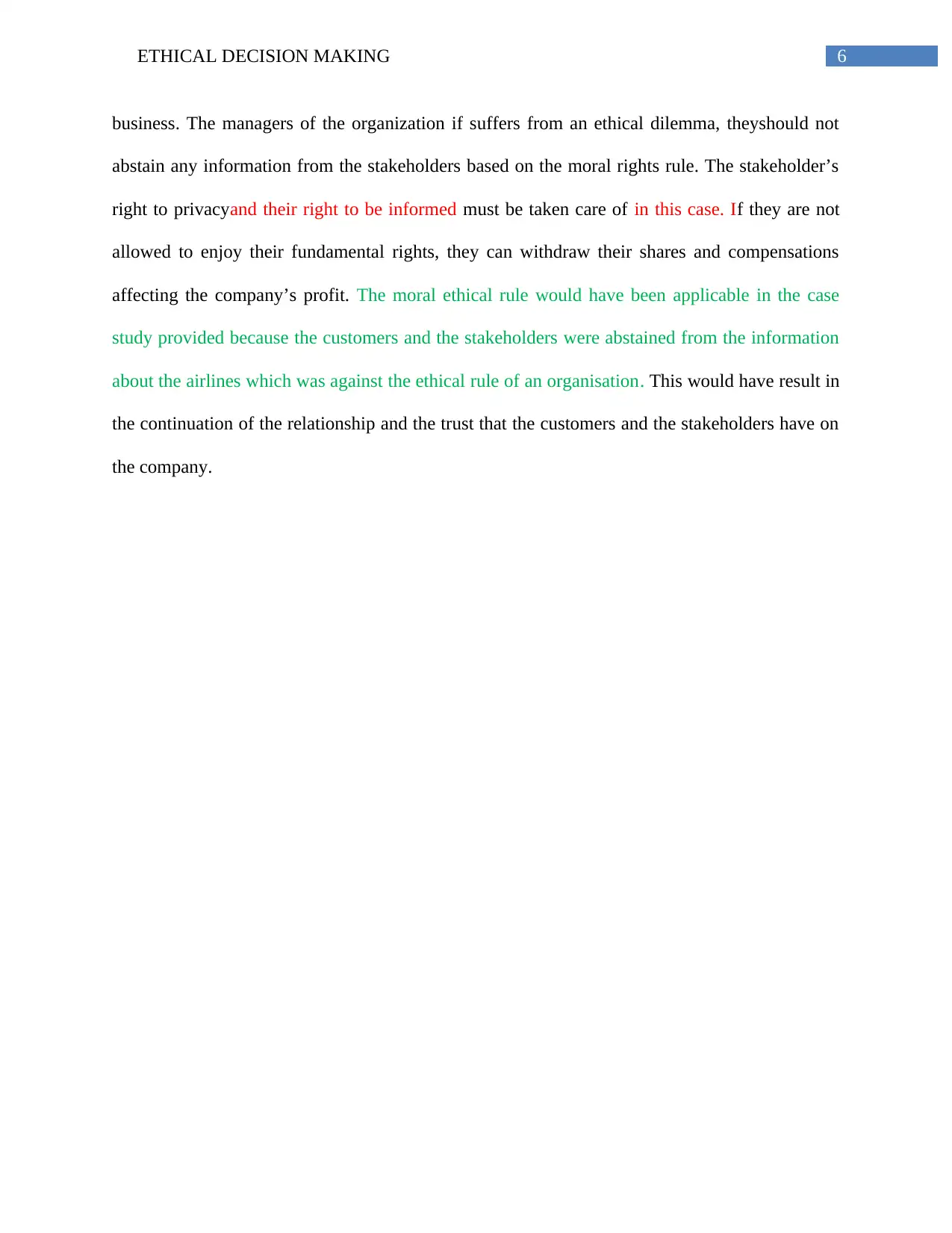
6ETHICAL DECISION MAKING
business. The managers of the organization if suffers from an ethical dilemma, theyshould not
abstain any information from the stakeholders based on the moral rights rule. The stakeholder’s
right to privacyand their right to be informed must be taken care of in this case. If they are not
allowed to enjoy their fundamental rights, they can withdraw their shares and compensations
affecting the company’s profit. The moral ethical rule would have been applicable in the case
study provided because the customers and the stakeholders were abstained from the information
about the airlines which was against the ethical rule of an organisation. This would have result in
the continuation of the relationship and the trust that the customers and the stakeholders have on
the company.
business. The managers of the organization if suffers from an ethical dilemma, theyshould not
abstain any information from the stakeholders based on the moral rights rule. The stakeholder’s
right to privacyand their right to be informed must be taken care of in this case. If they are not
allowed to enjoy their fundamental rights, they can withdraw their shares and compensations
affecting the company’s profit. The moral ethical rule would have been applicable in the case
study provided because the customers and the stakeholders were abstained from the information
about the airlines which was against the ethical rule of an organisation. This would have result in
the continuation of the relationship and the trust that the customers and the stakeholders have on
the company.
Paraphrase This Document
Need a fresh take? Get an instant paraphrase of this document with our AI Paraphraser
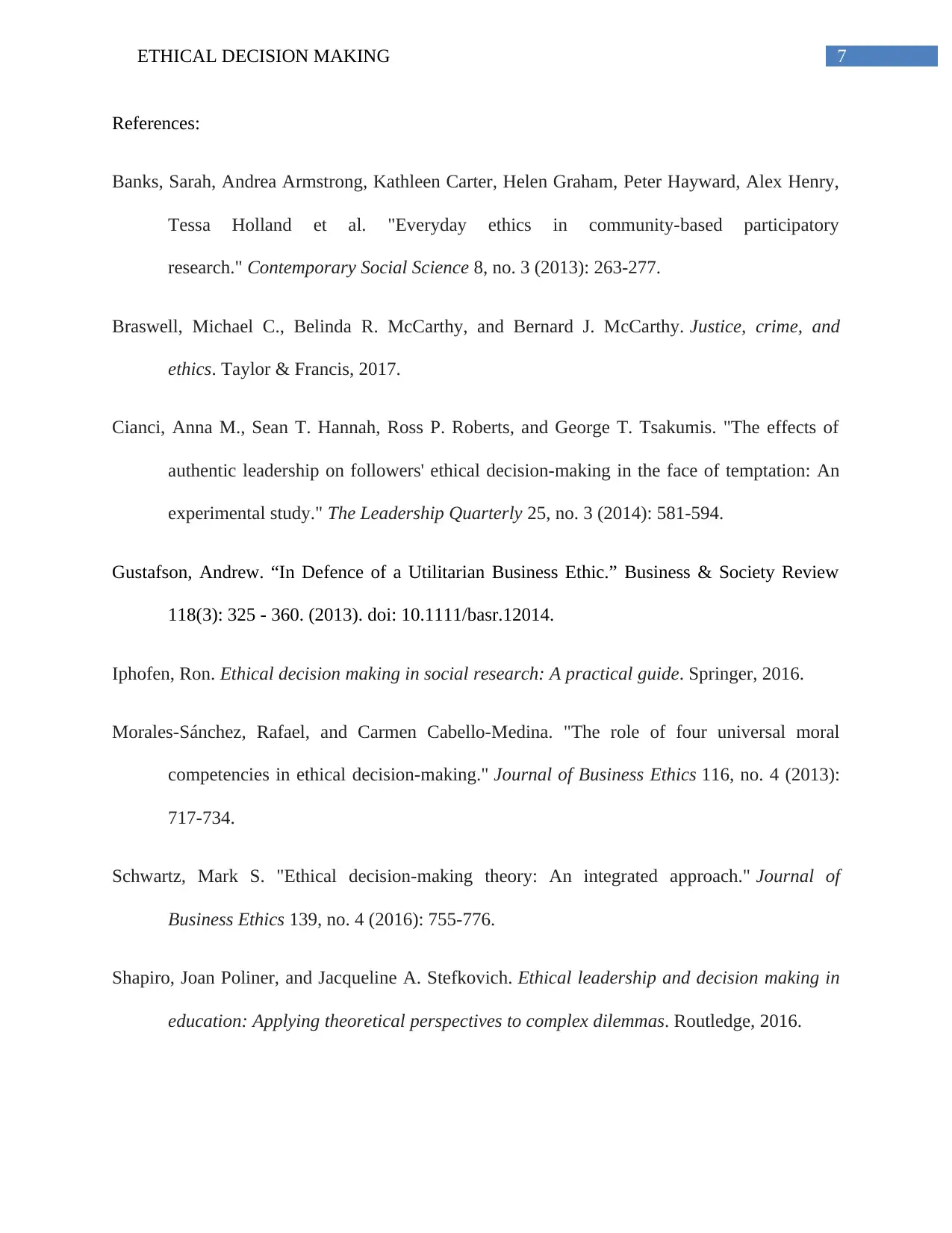
7ETHICAL DECISION MAKING
References:
Banks, Sarah, Andrea Armstrong, Kathleen Carter, Helen Graham, Peter Hayward, Alex Henry,
Tessa Holland et al. "Everyday ethics in community-based participatory
research." Contemporary Social Science 8, no. 3 (2013): 263-277.
Braswell, Michael C., Belinda R. McCarthy, and Bernard J. McCarthy. Justice, crime, and
ethics. Taylor & Francis, 2017.
Cianci, Anna M., Sean T. Hannah, Ross P. Roberts, and George T. Tsakumis. "The effects of
authentic leadership on followers' ethical decision-making in the face of temptation: An
experimental study." The Leadership Quarterly 25, no. 3 (2014): 581-594.
Gustafson, Andrew. “In Defence of a Utilitarian Business Ethic.” Business & Society Review
118(3): 325 - 360. (2013). doi: 10.1111/basr.12014.
Iphofen, Ron. Ethical decision making in social research: A practical guide. Springer, 2016.
Morales-Sánchez, Rafael, and Carmen Cabello-Medina. "The role of four universal moral
competencies in ethical decision-making." Journal of Business Ethics 116, no. 4 (2013):
717-734.
Schwartz, Mark S. "Ethical decision-making theory: An integrated approach." Journal of
Business Ethics 139, no. 4 (2016): 755-776.
Shapiro, Joan Poliner, and Jacqueline A. Stefkovich. Ethical leadership and decision making in
education: Applying theoretical perspectives to complex dilemmas. Routledge, 2016.
References:
Banks, Sarah, Andrea Armstrong, Kathleen Carter, Helen Graham, Peter Hayward, Alex Henry,
Tessa Holland et al. "Everyday ethics in community-based participatory
research." Contemporary Social Science 8, no. 3 (2013): 263-277.
Braswell, Michael C., Belinda R. McCarthy, and Bernard J. McCarthy. Justice, crime, and
ethics. Taylor & Francis, 2017.
Cianci, Anna M., Sean T. Hannah, Ross P. Roberts, and George T. Tsakumis. "The effects of
authentic leadership on followers' ethical decision-making in the face of temptation: An
experimental study." The Leadership Quarterly 25, no. 3 (2014): 581-594.
Gustafson, Andrew. “In Defence of a Utilitarian Business Ethic.” Business & Society Review
118(3): 325 - 360. (2013). doi: 10.1111/basr.12014.
Iphofen, Ron. Ethical decision making in social research: A practical guide. Springer, 2016.
Morales-Sánchez, Rafael, and Carmen Cabello-Medina. "The role of four universal moral
competencies in ethical decision-making." Journal of Business Ethics 116, no. 4 (2013):
717-734.
Schwartz, Mark S. "Ethical decision-making theory: An integrated approach." Journal of
Business Ethics 139, no. 4 (2016): 755-776.
Shapiro, Joan Poliner, and Jacqueline A. Stefkovich. Ethical leadership and decision making in
education: Applying theoretical perspectives to complex dilemmas. Routledge, 2016.
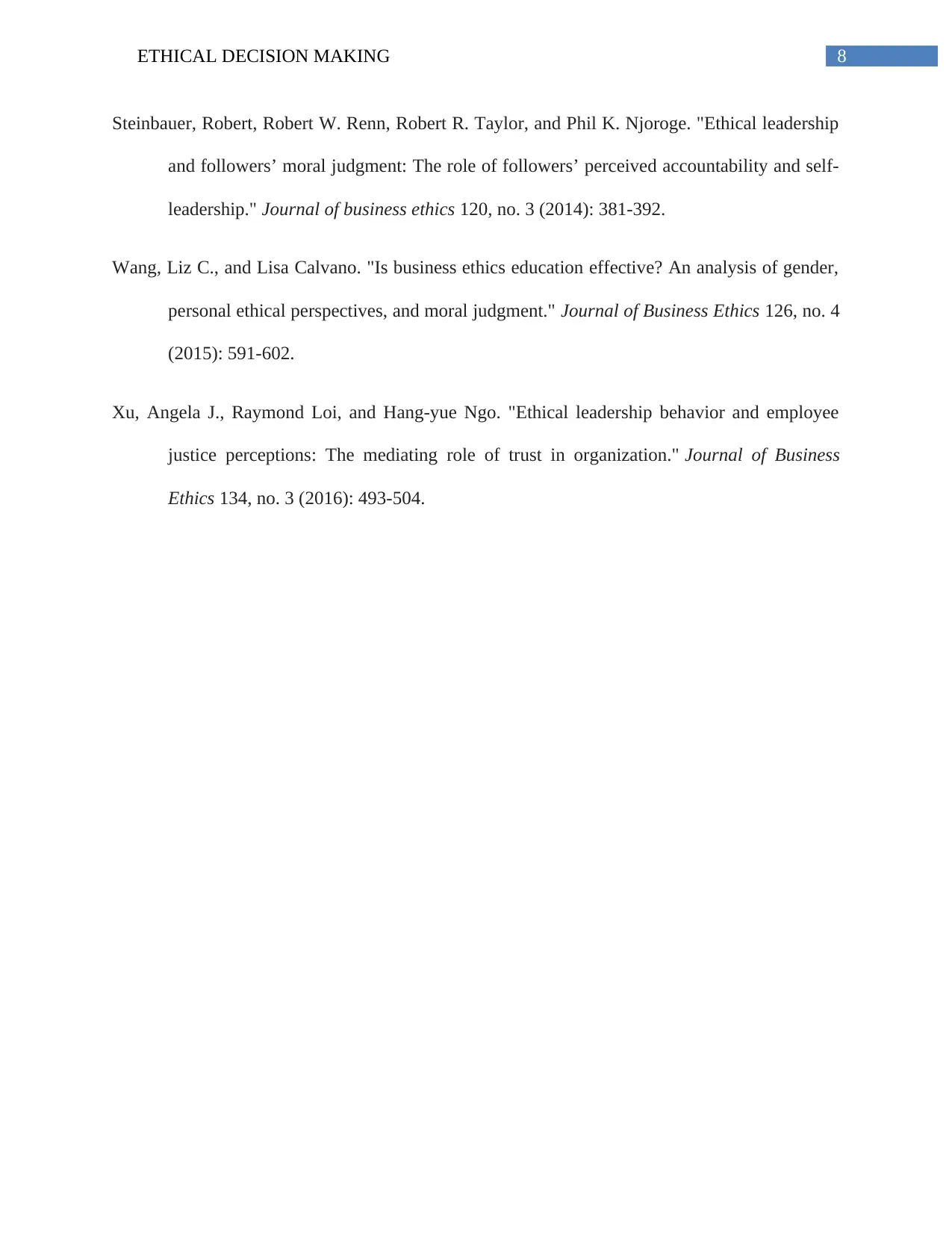
8ETHICAL DECISION MAKING
Steinbauer, Robert, Robert W. Renn, Robert R. Taylor, and Phil K. Njoroge. "Ethical leadership
and followers’ moral judgment: The role of followers’ perceived accountability and self-
leadership." Journal of business ethics 120, no. 3 (2014): 381-392.
Wang, Liz C., and Lisa Calvano. "Is business ethics education effective? An analysis of gender,
personal ethical perspectives, and moral judgment." Journal of Business Ethics 126, no. 4
(2015): 591-602.
Xu, Angela J., Raymond Loi, and Hang-yue Ngo. "Ethical leadership behavior and employee
justice perceptions: The mediating role of trust in organization." Journal of Business
Ethics 134, no. 3 (2016): 493-504.
Steinbauer, Robert, Robert W. Renn, Robert R. Taylor, and Phil K. Njoroge. "Ethical leadership
and followers’ moral judgment: The role of followers’ perceived accountability and self-
leadership." Journal of business ethics 120, no. 3 (2014): 381-392.
Wang, Liz C., and Lisa Calvano. "Is business ethics education effective? An analysis of gender,
personal ethical perspectives, and moral judgment." Journal of Business Ethics 126, no. 4
(2015): 591-602.
Xu, Angela J., Raymond Loi, and Hang-yue Ngo. "Ethical leadership behavior and employee
justice perceptions: The mediating role of trust in organization." Journal of Business
Ethics 134, no. 3 (2016): 493-504.
⊘ This is a preview!⊘
Do you want full access?
Subscribe today to unlock all pages.

Trusted by 1+ million students worldwide
1 out of 9
Related Documents
Your All-in-One AI-Powered Toolkit for Academic Success.
+13062052269
info@desklib.com
Available 24*7 on WhatsApp / Email
![[object Object]](/_next/static/media/star-bottom.7253800d.svg)
Unlock your academic potential
Copyright © 2020–2025 A2Z Services. All Rights Reserved. Developed and managed by ZUCOL.





